Bosch DIE 165 R User Manual
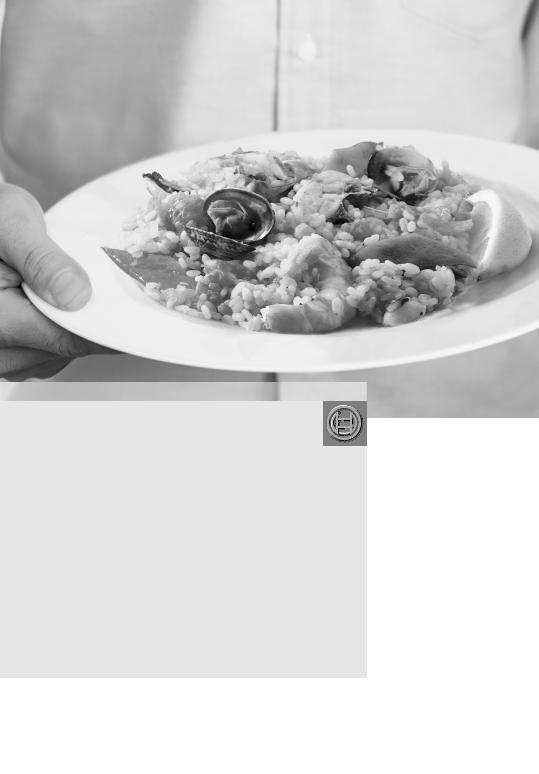
DIE 165 R
en Operating and installation instructions
fr Mode d’emploi et notice de montage
es Instrucciones de uso y de montaje
Internet: http://www.bosch-hausgeraete.de
Bosch Info-Team: de Tel. 01 80/5 30 40 50 (E 0,14/Min. DTAG)
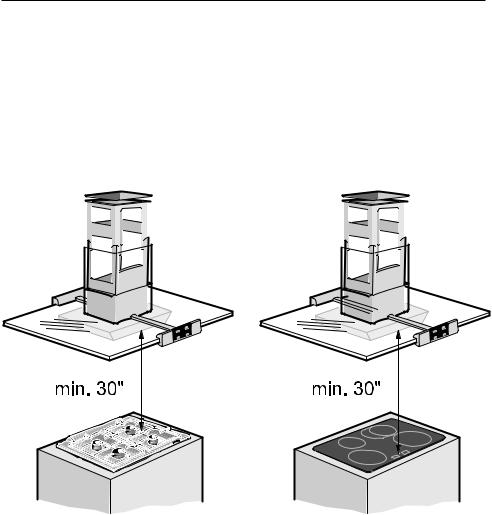
en
fr
page |
03 – 16 |
pages |
17 – 30 |
es |
página |
31 – 44 |
Fig. 1 |
|
Abb. 1 |
|
GAZ |
|
ELECTRO |
|
|
|
|
|
|
|
|
|
|
|
|
|
|
|
|
|
|
|
|
|
2
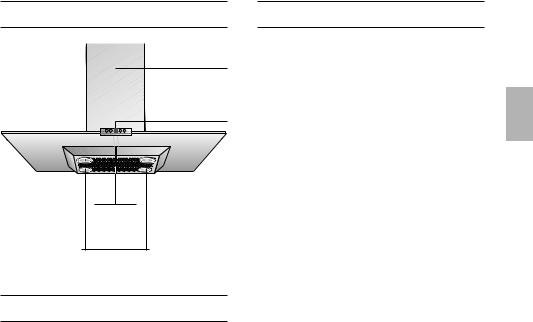
Instructions for use:
Appliance description
Chimney |
panelling |
Light / fan |
switches |
Filter
grille
Lighting
Operating modes
Exhaust-air mode:
The extractor-hood fan extracts the kitchen vapours and conveys them through the grease filter into the atmosphere.
The grease filter absorbs the solid particles in the kitchen vapours.
The kitchen is kept almost free of grease and odours.
WARNING
When the extractor hood is operated in exhaust-air mode simultaneously with a different burner which also makes use of the same chimney (such as gas, oil or coal-fired heaters, continuous-flow heaters, hot-water boilers) care must be taken to ensure that there is an adequate supply of fresh air which will be needed by the burner for combustion.
Safe operation is possible provided that the underpressure in the room where the burner is installed does not exceed 4 Pa (0.04 mbar).
Operating modes
This can be achieved if the combustion air is able to flow through non-lockable openings, e.g. in doors, windows and in conjunction with an air supply/air-intake wall box or by other technical procedures such as reciprocal interlocking.
If the air intake is inadequate, there is a risk of poisoning from combustion gases which are drawn back into the room.
An air-intake/exhaust-air wall box by itself is no guarantee that the limiting value will not be exceeded.
Note: When assessing the overall requirement, the combined ventilation system for the entire household must be taken into consideration. This rule does not apply to the use of cooking appliances, such as hobs and ovens.
3
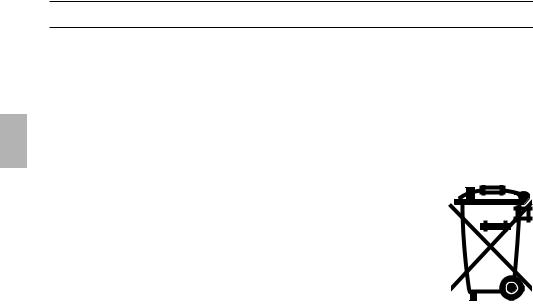
Before using for the first time
Important notes:
The Instructions for Use apply to several versions of this appliance. Accordingly, you may find descriptions of individual features that do not apply to your specific appliance.
This extractor hood complies with all relevant safety regulations.
Repairs should be carried out by qualified technicians only.
CAUTION
Improper repairs may put the user at considerable risk.
Before using your appliance for the first time, please read these Instructions for Use carefully. They contain important information concerning your personal safety as well as on use and care of the appliance.
Please retain the operating and installation instructions for a subsequent owner.
This appliance is labelled
in accordance with  European Directive 2002/96/EG concerning used electrical and
European Directive 2002/96/EG concerning used electrical and
electronic appliances (waste electrical and electronic equipment – WEEE). The guideline
determines the framework for the return and recycling of used appliances as applicable throughout the EU.
Gas hobs / Gas cookers
Do not use all the gas hotplates simultaneously for a prolonged period (max. 15 minutes) at maximum thermal load, otherwise there is a risk of burns if the housing surfaces are touched or a risk of damage to the extractor hood. If the extractor hood is situated over a gas hob, operate the hood at maximum setting if three or more gas hotplates are operated simultaneously.
4
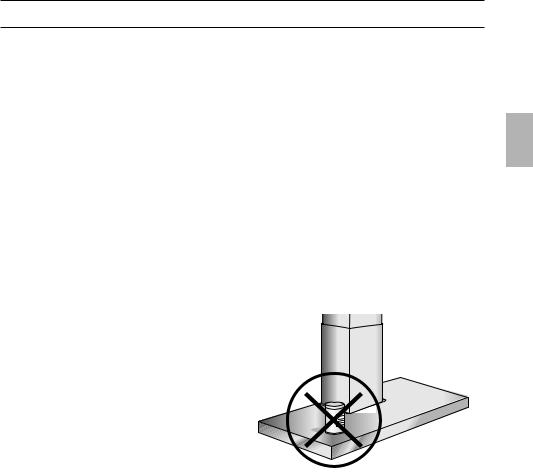
Before using for the first time
SAFETY INSTRUCTIONS
Do not flambé food directly under the extractor hood.
Risk of grease filter catching fire due to flames.
The hotplates must always be covered with a utensil.
The extractor hood must not be
operated above a solid-fuel or gas fire (coal, wood, etc.) (see installation instructions).
Do not operate all hotplates simultaneously over a prolonged period (max. 15 minutes) at maximum thermal load, otherwise there is a risk of burns from touching the housing surfaces or a risk of damaging the extractor hood. When operating the extractor hood above a hob, operate the hood at maximum setting if three or more hotplates are on at the same time.
Do not use the appliance if damaged.
The appliance is not intended for use by young children or infirmed persons without supervision.
Young children should be supervised to ensure they do not play with the appliance.
When children become old enough to use the appliance, it is the legal responsibility of the parents or legal guardian to ensure that they are instructed in its safe use by qualified persons.
If the connecting cable for this
appliance is damaged, the cable must be replaced by the manufacturer or his customer service or a similarly qualified person in order to prevent serious injury to the user.
The appliance must be connected to the mains by a qualified technician only.
Dispose of packaging materials properly (see Installation instructions).
Safety instructions
This extractor hood is designed for domestic use only.
Light bulbs must always be fitted when the extractor hood is in use.
Defective bulbs should be replaced immediately to prevent the remaining bulbs from overloading.
Never operate the extractor hood without a grease filter.
Overheated fat or oil can easily catch fire. If you are cooking with fat or oil, e.g. chips, etc., never leave the cooker unattended.
Carefully clean the extractor hood before switching on for the first time.
Do not place any objects on the extractor hood.
5
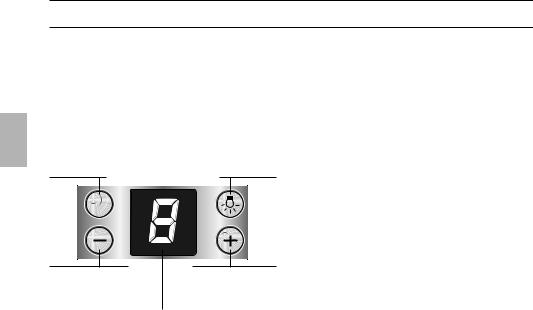
Operating procedure
The most effective method of removing vapours produced during cooking is to:
Switch the ventilator ON
as soon as you begin cooking.
Switch the ventilator OFF
a few minutes after you have finished cooking.
Fan OFF |
Light |
ON / OFF |
0 |
Reduce fan |
Fan ON and |
|
speed |
increase speed |
|
|
|
Intensive setting |
|
|
Display for fan setting |
Acoustic signal:
When a button is pressed, this is verified by an acoustic signal.
Switching off the acoustic signal:
Simultaneously press buttons 0 and + until a signal is emitted after approx. 3 seconds.
Switching on the acoustic signal:
Repeat the process.
Switching the fan ON
Press the + button.
Setting the required fan speed:
Press the + button.
The fan speed is increased by one step.
Press the – button.
The fan speed is reduced by one step.
Switching the fan OFF:
Press the 0 button.
Or:
Keep pressing the – button until the fan switches off.
Intensive setting:
Maximum power is obtained at the intensive setting. It is only required for short intervals.
Keep pressing the + button until a ç appears in the display.
If the intensive setting is not cancelled by
hand, the fan will automatically switch back to step } after 10 minutes.
Lighting:
The light can be switched on at any time, even though the fan is switched off.
Adjusting the brightness:
Hold down the 0 button until the desired brightness is obtained.
6
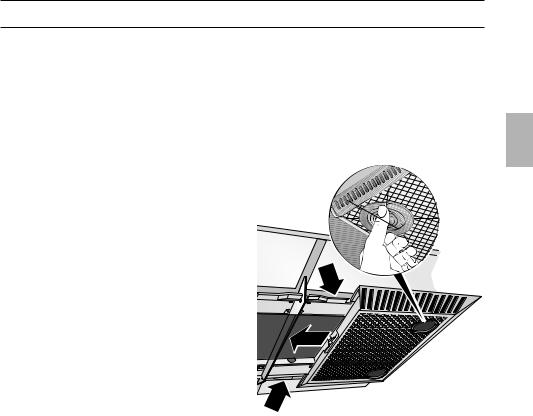
Filters and maintenance
Grease filters:
Metal filters are used to trap the greasy element of the vapours that develop during cooking.
The filter mats are made from noncombustible metal.
CAUTION
As the filter becomes more and more saturated with grease, not only does the risk of it catching fire increase but the efficiency of the extractor hood can also be adversely affected.
IMPORTANT
By cleaning the metal grease filters at appropriate intervals, the possibility of them catching fire as a result of a build-up of heat such as occurs when deep-fat frying or roasting is taking place, is reduced.
Saturation indicator: #
When the grease filters reach saturation point, an acoustic signal is sounded for 6 seconds after the fan has switched off,
and an # appears in the display. The grease filters should be cleaned straight away.
Cleaning the metal grease filters:
In normal operation (1 to 2 hours daily), the metal grease filter must be cleaned 1 x a month.
The filters can be cleaned in a dishwasher. It is however possible that they will become slightly discoloured.
The filter must be placed loosely, and NOT wedged, in the dishwasher.
IMPORTANT:
Metal filters that are saturated with grease should not be washed together with other dishes etc.
When cleaning the filters by hand, soak them in hot soapy water first of all.
Do not use aggressive, acidic or caustic cleaners.
Then brush the filters clean, rinse them thoroughly and leave the water to drain off.
Removing and inserting the metal grease filters:
WARNING
The halogen bulbs must be switched off and cool.
1.Rotate the two catches on the grease filter and remove the grease filter sideways.
2.Clean the grease filter.
3.Re-insert the clean grease filter.
4.Cancel the # in the display.
Press the – button.
7

Cleaning and care
Isolate the extractor hood by pulling out the mains plug or switching off the fuse.
NOTE:
Do not clean the extractor hood with abrasive sponges or with cleaning agents which contain sand, soda, acid or chlorine!
Clean the extractor hood with a hot soap solution or a mild window cleaner.
Do not scrape off dried-on dirt but wipe off with a damp cloth.
When cleaning the grease filters, remove grease deposits from accessible parts of the housing. This prevents the risk of fire and ensures that the extractor hood continues operating at maximum efficiency.
Screen and control buttons:
Clean with a mild detergent solution and a soft, damp cloth only.
Do not use stainless steel cleaners.
Stainless steel surfaces:
Use a mild non-abrasive stainless steel cleaner.
Clean the surface in the same direction as it has been ground and polished.
We recommend our stainless steel cleaner no. 461731.
See enclosed service booklet for order address.
Aluminium, coated and plastic surfaces:
Do not use dry cloths.
Use a mild window cleaning agent.
Do not use aggressive, acidic or caustic cleaners.
Observe the warranty regulations in the enclosed service booklet.
8
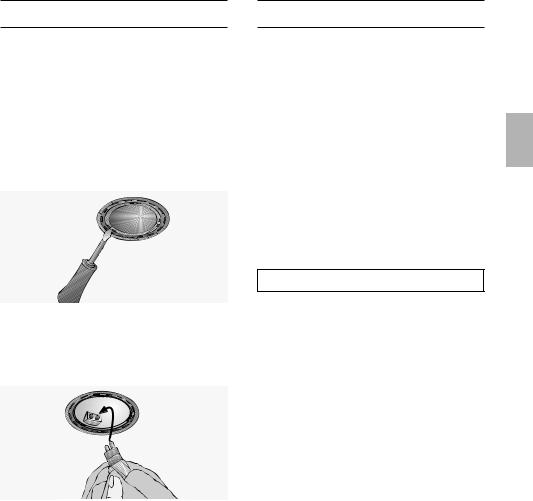
Replacing the light bulbs
1. Switch off the extractor hood and pull out the mains plug or switch off the electricity supply at the fuse box.
CAUTION:
When switched on, the halogen bulbs become very hot. Even for some time after the bulbs have been switched off there is still a risk of burns.
2.Remove the bulb ring with a screwdriver or similar tool.
3.Replace the halogen light bulb (conventional halogen bulb, 12 Volt, max. 20 Watt, G4 cap).
NOTE: Refer for plug-in lampholder. Take hold of the bulb with a clean cloth.
4.Re-insert the bulb ring.
5.Plug the appliance into the mains or switch it on at the fuse box.
NOTE:
If the light does not function, check that the bulbs have been inserted correctly.
If you encounter a problem
If an # appears in the display:
See "Filters and maintenance" Section.
If is not possible to operate the extractor hood:
Disconnect the extractor hood from the mains electricity supply by pulling out the plug or switching it off at the main fuse box.
Wait for approx. 1 minute and then switch it on again.
If you have any questions or if a fault occurs, please call Customer Service.
(See list of Customer Service representatives).
When you call, please quote the following:
E-Nr. FD
Enter the relevant numbers into the box above. The E-Nr. (product no.) and FD (production date) are shown on the nameplate which can be seen inside the extractor hood after the filter frame has been detached.
IMPORTANT:
The manufacturer of the extractor hoods accepts no liability for complaints which can be attributed to the design and layout of the pipework.
9

Installation Instructions:
Important information
Old appliances are not worthless rubbish. Valuable raw materials can be reclaimed by recycling old appliances. Before disposing of your old appliance, render it unusable.
You received your new appliance in a protective shipping carton. All packaging materials are environmentally friendly and recyclable. Please contribute to a better environment by disposing of packaging materials in an environmentally-friendly manner.
Please ask your dealer or inquire at your local authority about current means of disposal.
The extractor hood can only be used in exhaust air mode.
Always mount the extractor hood over the centre of the hob.
Minimum distance between electric hob and bottom edge of extractor hood: 30”, Fig. 1.
The extractor hood must not be installed over a solid fuel cooker – a potential fire hazard (e.g. flying sparks) – unless the cooker features a closed, non-removable cover and all national regulations are observed.
The smaller the gap between the extractor hood and hotplates, the greater the likelihood that droplets will form on the underside of the extractor hood.
Additional information concerning gas cookers:
When installing gas hotplates, comply with the relevant national statutory
regulations (e.g. in Germany: Technische Regeln Gasinstallation TRGI).
Always comply with the currently valid regulations and installation instructions supplied by the gas appliance manufacturer.
Only one side of the extractor hood may be installed next to a high-sided unit or high wall. Gap at least 2”.
Minimum distance on gas hotplates between the upper edge of the trivet and lower edge of the extractor hood: 30”, Fig. 1.
10

Prior to installation
Exhaust-air mode
The exhaust air is discharged upwards through a ventilation shaft or directly through the outside wall into the open.
WARNING
Exhaust air should neither be directed into a smoke or exhaust flue that is currently used for other purposes, nor into a shaft that is used for ventilating rooms in which stoves or fireplaces are also located.
Exhaust air may be discharged in accordance with official and statutory regulations only (e.g. national building regulations).
Local authority regulations must be observed when discharging air into smoke or exhaust flues that are not otherwise in use.
WARNING
When the extractor hood is operated in exhaust-air mode simultaneously with a different burner which also makes use of the same chimney (such as gas, oil or coal-fired heaters, continuous-flow heaters, hot-water boilers) care must be taken to ensure that there is an adequate supply of fresh air which will be needed by the burner for combustion.
Safe operation is possible provided that the underpressure in the room where the burner is installed does not exceed 4 Pa (0.04 mbar).
This can be achieved if combustion air can flow through non-lockable openings, e.g. in doors, windows and via the air- intake/exhaust-air wall box or by other technical measures, such as reciprocal interlocking, etc.
If the air intake is inadequate, there is a risk of poisoning from combustion gases which are drawn back into the room.
An air-intake/exhaust-air wall box by itself is no guarantee that the limiting value will not be exceeded.
Note: When assessing the overall requirement, the combined ventilation system for the entire household must be taken into consideration. This rule does not apply to the use of cooking appliances, such as hobs and ovens.
If the exhaust air is going to be discharged into the open, a telescopic wall box should be fitted into the outside wall.
11
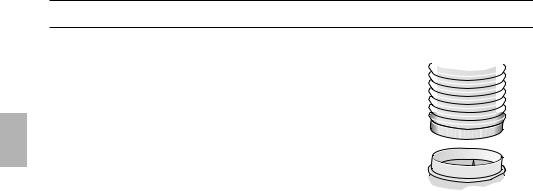
Prior to installation
For optimum extractor hood efficiency:
Short, smooth air exhaust pipe.
As few bends in the pipe as possible.
Diameter of pipe to be as large as possible and no tight bends in pipe.
If long, rough exhaust-air pipes, many pipe bends or smaller pipe diameters are used, the air extraction rate will no longer be at an optimum level and there will be an increase in noise.
IMPORTANT:
The manufacturer of the extractor hoods accepts no liability for complaints which can be attributed to the design and layout of the pipework.
Round pipes:
We recommend Internal diameter: 6”.
Flat ducts must have an internal crosssection that equates to that of round pipes.
There should be no sharp bends. l 6” approx. 28,3 inches2
If pipes have different diameters:
Insert sealing strip.
For exhaust-air mode, ensure that there is an adequate supply of fresh air.
Connecting a l 6” exhaust-air pipe:
Mount the pipe directly onto the air outlet on the hood.
12

Prior to installation
Preparing the ceiling
The ceiling must be flat and horizontal.
Ensure that the ceiling is capable of providing a firm hold for mounting screws and plugs. The enclosed plugs are suitable for concrete and stonework. If the ceiling is made of any other material, use appropriate mounting components.
Weight in kg: 40,5.
We reserve the right to construction changes within the context of technical development.
Electrical connection
WARNING: THIS APPLIANCE MUST BE EARTHED
IMPORTANT: Fitting a Different Plug:
The wires in the mains lead are coloured in accordance with the following code:
Green and Yellow |
– |
Earth |
Blue |
– |
Neutral |
Brown |
– |
Live |
If you fit your own plug, the colours of these wires may not correspond with the identifying marks on the plug terminals.
This is what you have to do:
1.Connect the green and yellow (Earth) wire to the terminal in the plug marked ‘E’ or with the symbol (  ), or coloured green or green and yellow.
), or coloured green or green and yellow.
2.Connect the blue (Neutral) wire to the terminal in the plug marked ‘N’ or coloured white.
3.Connect the brown (Live) wire to the terminal marked ‘L’, or coloured black.
Electrical connection
The extractor hood may be connected to correctly installed earthed sockets only. Preferably attach the earthed sockets directly behind the flue duct.
NOTE:
An additional earthed socket is required for connecting the screen to the power supply.
The earthed socket should be connected via its own circuit.
If the earthed socket is no longer accessible following installation of the extractor hood, ensure that there is a permanently installed disconnector.
If it is necessary to wire the extractor hood directly into the mains:
The extractor hood should only be connected to the electricity supply by a properly qualified electrician.
A separator must be installed in the household circuit. A suitable separator is a switch that has a contact gap of more than 1/8” and interrupts all poles. Such devices include circuit breakers and contactors.
CAUTION:
If the connecting cable for this appliance is damaged, the cable must be replaced by the manufacturer or his customer service or a similarly qualified person in order to prevent serious injury to the user.
Electrical data:
Are to be found on the name plate inside the appliance after removal of the filter frame.
WARNING: Before undertaking any repairs, always disconnect the extractor hood from the electricity supply.
Length of the connecting cable: 511/8”.
This extractor hood corresponds to EC regulations concerning RF interference suppression.
13
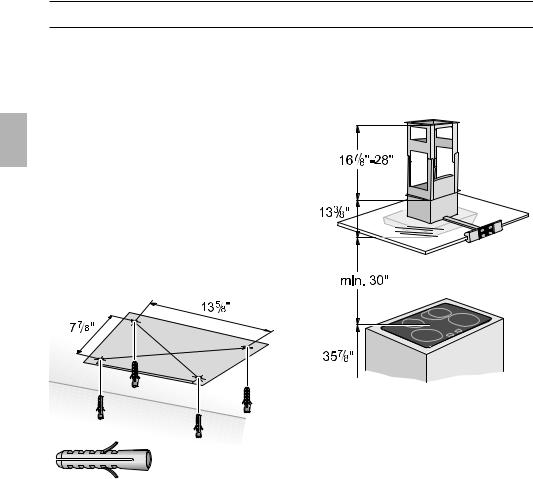
Installation
The extractor hood is designed to be fitted to the kitchen ceiling or a rigid suspended ceiling.
CAUTION:
Ensure that the minimum distance between hotplate and extractor hood is 30” for electric hotplates and 30” for gas hotplates.
1.Mark the centre point of the extractor hood on the ceiling.
2.Using the template, mark screw positions on the ceiling.
3.Drill 2x 1/4” ø holes and insert wall plugs flush with the ceiling.
Note: At least one screw for the mounting must be installed through a stud.
4.Determine the overall height of the support frame.
–This is the height of the ceiling, the height of the base and the distance between the hob and extractor hood.
14
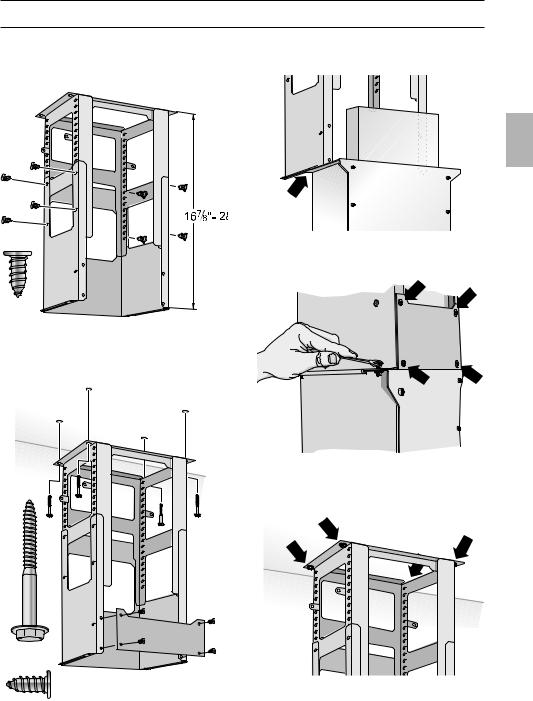
Installation
5.Screw together the upper and lower sections of the support frame at the specified overall height with 8 screws.
6.Screw the support frame to the ceiling with 4 screws.
7.Remove the panel.
08. Insert the extractor hood over the installation aids on the support frame.
09. Screw the extractor hood to the support frame and screw back the panel.
10.Align the extractor hood. To do this, loosen the ceiling screws in the support frame.
15 |
